
views
What is Asr?

Asr is one of the 5 mandatory (Fard) daily prayers for every Muslim. The 5 mandatory prayers, also known as Salah or Namaaz, are the second pillar of Islam and a key component of an Islamic life. Asr is known as the afternoon prayer, since this is the time of day during which it takes place. Through prayer, you can form a divine spiritual link with Allah, purify your sins, encourage self-reflection, grow spiritually, and make yourself worthy of Allah’s forgiveness.
When do I pray Asr?

Asr should be prayed every day, when the sun is halfway between noon and sunset. Since prayer times depend on the location of the sun, most Muslims use a timetable provided by their local mosque to know when to pray. You can also find the correct times for prayer online. Although missing these prayers should be avoided at all costs, if you forget or sleep through Asr, you’re permitted to make it up as soon as you remember to do it.

Women who are menstruating do not need to pray Asr. The same is true for women who are experiencing bleeding post-birth. If you’re currently menstruating, you should not pray until you’ve stopped—there’s no need to make up for any missed prayers during this time. If you’re physically disabled, keep in mind that each rakat is generally requires movement that includes kneeling, prostrating, and standing back up. If you can’t perform these actions, sitting or lying down to pray is permitted. Mustafa Umar Mustafa Umar, Islamic Theologian & Preacher The Asr prayer is the afternoon prayer recited by Muslims. To perform Asr, make ablution, face the Qiblah, and recite Surah Al-Fatihah. Then bow, prostrate twice, and conclude while sitting if possible. Asr has four rakat fardh or obligatory units, making it longer than other daily prayers besides Maghrib. Focus the mind and heart during Asr by pondering the meaning of recitations and Allah’s greatness.
How many rakats are in Asr?
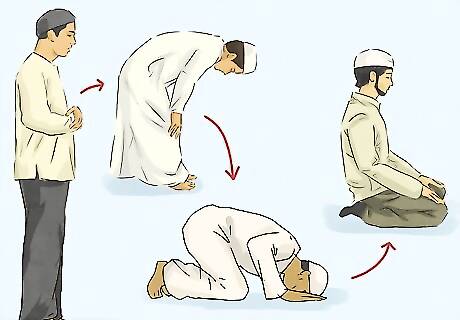
Asr consists of 4 obligatory rakats. A rakat is prayer unit in Islam, during which Muslims go through a series of prescribed prayers and actions. Each rakat takes about a minute to pray, meaning that praying Asr will taken you around 4 minutes total. If you’re praying in a mosque along with an imam, however, it may take longer. Keep in mind that it’s considered a sin to rush through your prayers in Islam. Take your time when praying Asr.
What do I need to do before praying Asr?

Perform wudu or ghusl. These Islamic rituals of purification are themselves acts of worship, and are necessary before prayer. Perform wudu if you’ve used the restroom, passed gas, entered into deep sleep, or touched your genitals since the last time you did either wudu or ghusl. If you’ve engaged in sexual activity or have been menstruating, perform ghusl instead.
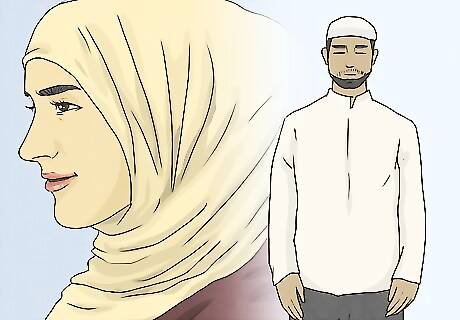
Dress modestly. Both men and women are required to dress modestly during prayer. Men should wear at least enough clothing to cover the back and front of their bodies between their belly buttons and their knees, as well as cover their shoulders. Women need to cover their entire bodies, with exception of their hands and faces. Both men and women should wear loose clothing that isn’t transparent.
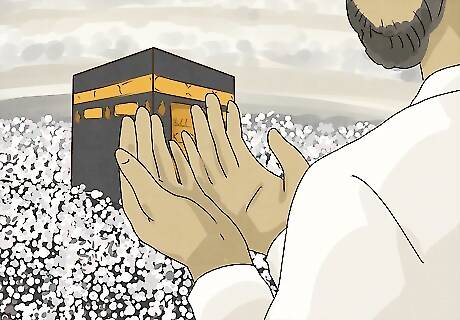
Face the Qibla. Muslims are required to pray toward the Qibla, which is the name given to the direction of the holy mosque in Mecca. There are special compasses and websites that can help you locate the Qibla no matter where in the world you are.
How to Pray Asr

Make an intention to pray. Think about the prayer you intend to perform, and mentally note your intention to perform it. You can do this in English or whichever language you’d like. For instance, you might say something in your mind like: “I intend to pray 4 rakat for Asr today.”

Enter Qiyam and say the Takbir. Qiyam is a standing position, during which you stand with your hands folded in front of you. From this position, raise your hands up to your ears and say the Takbir: “Allahu akbar” (“God is great”). After you say the Takbir, lower your hands again.

Recite the opening supplication (optional). Many people perform a short dua (supplication) after this prayer, which is sunnah, meaning that the prophet (PBUH) practiced this, but it is not obligatory. If you’d like to recite this dua, you can say the following: “Subhanaka Allahumma wa bihamdika wa tabarakasmuka, wa ta’ala jadduka wa la ilaha ghairuk” Meaning: “Glorious You are O Allah, and with Your praise, and blessed is Your Name, and exalted is Your majesty, and none has the right to be worshipped but You.”
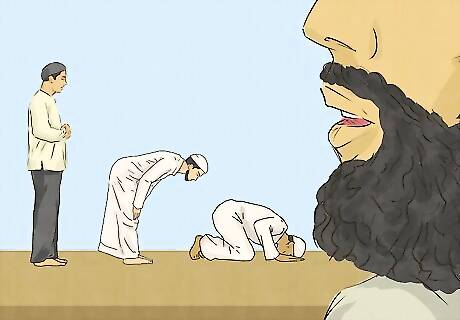
Begin the first rakat by reciting Surah al-Fatiha. Each rakat begins with the recitation of Surah al-Fatiha, the first chapter of the Quran. After reciting this chapter, it’s conventional to say “Ameen.” Surah al-Fatiha goes as follows: “Bismillaahir Rahmaanir Raheem Alhamdu lillaahi Rabbil ‘aalameen Ar-Rahmaanir-Raheem Maaliki Yawmid-Deen Iyyaaka na’budu wa lyyaaka nasta’een Ihdinas-Siraatal-Mustaqeem Siraatal-lazeena an’amta ‘alaihim ghayril-maghdoobi ‘alaihim wa lad-daaalleen” Meaning: “With the name of Allah, the All-Merciful, the Very-Merciful. Praise belongs to Allah, the Lord of all the worlds, the All-Merciful, the Very Merciful. the Master of the Day of Requital. You alone do we worship, and from You alone do we seek help. Take us on the straight path, the path of those on whom You have bestowed Your Grace, not of those who have incurred Your wrath, nor of those who have gone astray.”

Recite another section of the Quran. For your first two rakat, select another part of the Quran to recite after Surah al-Fatiha. You can choose any section of the Quran, but if you’re just beginning, one common selection is Surah Ikhlas, which goes as follows: “Bismillah hir Rahman nir Rahim Qul Huwallahu ahad. Allahussamad. Lam yalid wa lam yu-lad. Wa lam yakun lahu kufuwan ahad.” Meaning: “In the name of Allah, the most Gracious, the most Merciful. Say, He is Allah, the One. Allah is Eternal and Absolute. He begets not, nor was He begotten. And there is none co-equal unto Him.”
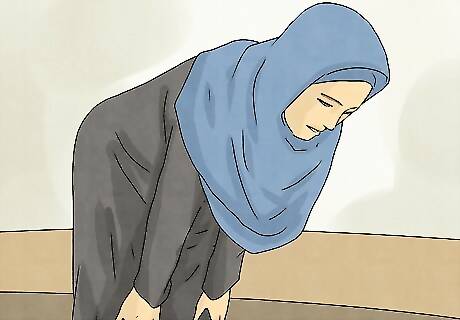
Enter Ruk’u and offer praise to Allah. Ruk’u is a bowing position, where you lean forward with your legs still straight. Move into this position by placing your torso almost parallel to the ground, and your hands on your knees. As you move into this position, say “Allahu Akbar,” then once you’re in Ruk’u, repeat the following prayer 3 times: “Subhaana rabbiyal ‘atheem” Meaning: “Glory be to my Lord, the Supreme.”

Return to Qiyam. Rise back into the standing position. As you do so, say the following words: “Sami’-Allahu liman hamidah” (“Allah listens to the one who praises Him.”). When you’re standing upright again, say, “Rabbana wa lakal hamd” (Our Lord, and to You belongs the praise.”).
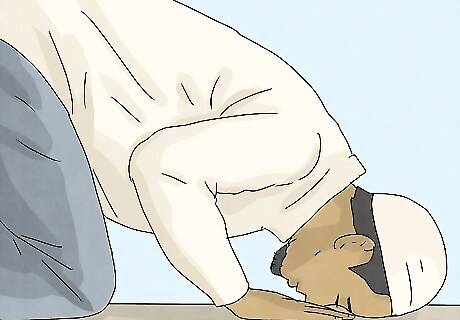
Enter Sujood. Sujood is a position during which you’ll be prostrating. Lower yourself to the ground, with your knees, nose, and forehead touching the floor. Place your palms on the floor as well, beside your head. As you lower yourself into Sujood, say “Allahu Akbar.” Then, when you’re in Sujood, repeat the following 3 times: “Subhaana rabbiyal ‘alaa.” Meaning: “Glory be to my Lord Most High.”
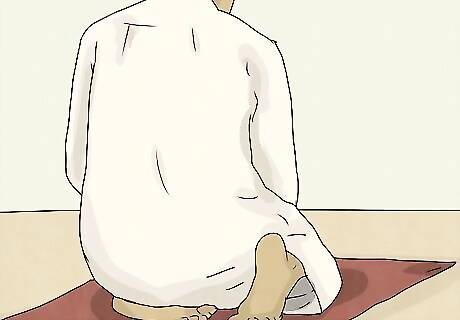
Rise into Juloos. Juloos is the sitting position. Sit on your knees, with your legs parallel with one another. Place the weight of your body on your left thigh. The toes of your right foot should be facing the Qiblah, and your hands should be placed on your knees. As you enter Juloos, say “Allahu Akbar.” Then, when you’re in the sitting position, repeat the following 3 times: “Rabbighfirlee” Meaning: “O Allah, forgive me.”
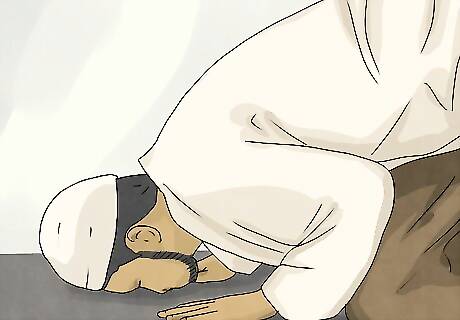
Enter Sujood again to complete the first rakat. Return to the prostration position, with your forehead and nose touching the floor. As you do so, say “Allahu Akbar.” When you’re in sujood, repeat the following three times in order to complete your first rakat: “Subhaana rabbiyal ‘alaa.” Meaning: “Glory be to my Lord Most High.”
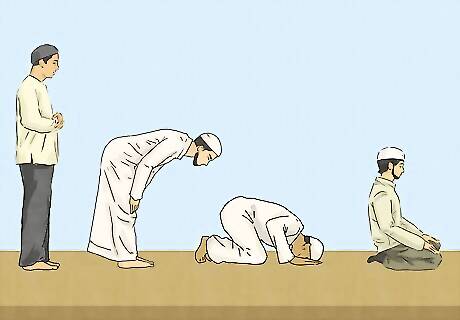
Repeat the first rakat as part of the second rakat. The steps of the second rakat are identical to the first rakat, just with the addition of the Tashahud at the end. Rise into Qiyam, then begin your second rakat from the recitation of Surah al-Fatiha.

Recite the Tashahud. At the end of the second rakat, rise from Sujood back into Juloos, the sitting position. In this position, you’ll recite the Tashahud, which goes as follows: “At-tahiy-yatu lil-lahi was-salawatu wat-taiyibatu . Assalamu 'Alaika aiyuhan-Nabiyu wa-rahmatul-lahi wa-barakatuhu. Assalamu alai-na wa-'ala i-ba-dil-lahis-sali-hin. Ash-hadu al-la ilaha il-lal-lahu wa ash-hadu an-na Muhammadan 'abdu hu wa Rasuluh.” Meaning: “All the compliments are for Allah and all the prayers and all the good things (are for Allah). Peace be on you, O Prophet, and Allah's mercy and blessings (are on you). And peace be on us and on the good (pious) worshipers of Allah. I testify that none has the right to be worshipped but Allah and that Muhammad is His slave and Apostle.”
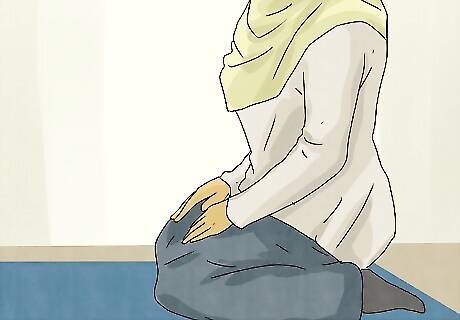
Perform the third rakat. After finishing the Tashahud, return to Qiyam to begin the third rakat, starting from the recitation of Surah al-Fatiha. Keep in mind that you do not need to recite an extra Surah after Fatiha during the third rakat. The third rakat is otherwise identical to the first rakat.
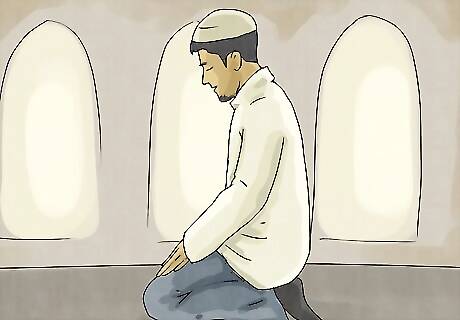
Perform the fourth rakat. After finishing the third rakat, rise from Sujood back into Qiyam. Begin this rakat from the recitation of Surah al-Fatiha. Like the third rakat, you do not need to recite an additional Surah after this. The fourth rakat is otherwise identical to the second rakat, including the recitation of the Tashahud afterwards.

Recite the Tashahud. Just as you did after the second rakat, following the fourth (and final rakat), say the Tashahud while sitting in the Juloos position. The Tashahud goes as follows: “At-tahiy-yatu lil-lahi was-salawatu wat-taiyibatu . Assalamu 'Alaika aiyuhan-Nabiyu wa-rahmatul-lahi wa-barakatuhu. Assalamu alai-na wa-'ala i-ba-dil-lahis-sali-hin. Ash-hadu al-la ilaha il-lal-lahu wa ash-hadu an-na Muhammadan 'abdu hu wa Rasuluh.” Meaning: “All the compliments are for Allah and all the prayers and all the good things (are for Allah). Peace be on you, O Prophet, and Allah's mercy and blessings (are on you). And peace be on us and on the good (pious) worshipers of Allah. I testify that none has the right to be worshipped but Allah and that Muhammad is His slave and Apostle.”

End the prayer with Taslim. After completing the four rakats, you’re ready to end the prayer. While sitting in Juloos, turn your head to the right and say “Assalamu alaikum wa rahmatullah” (“May the peace and mercy of Allah be upon you”). Then, turn your head to the left and repeat the phrase. The Asr prayer is now complete.



















Comments
0 comment